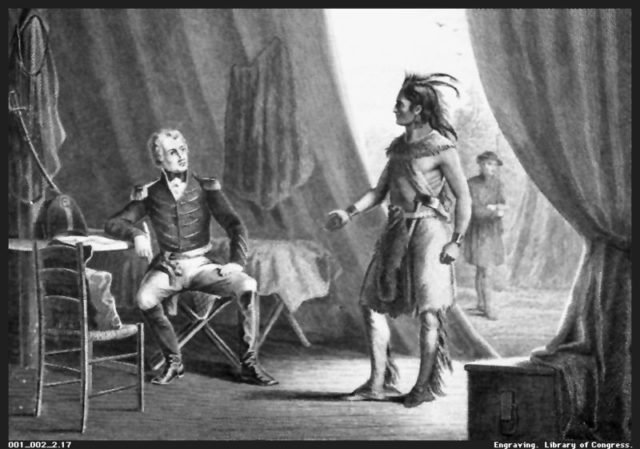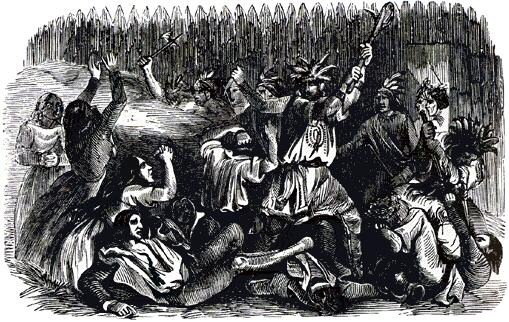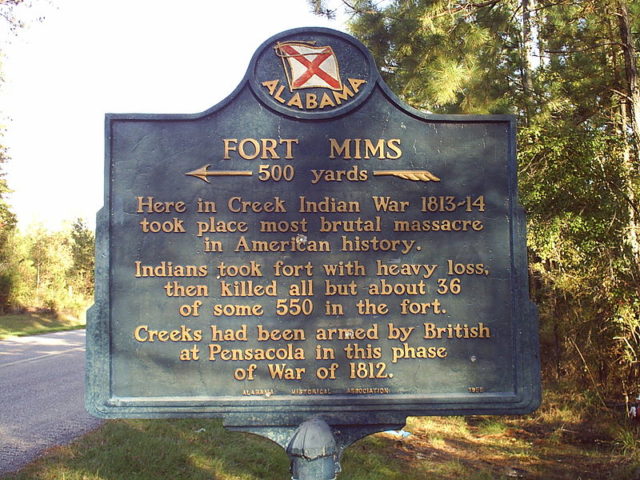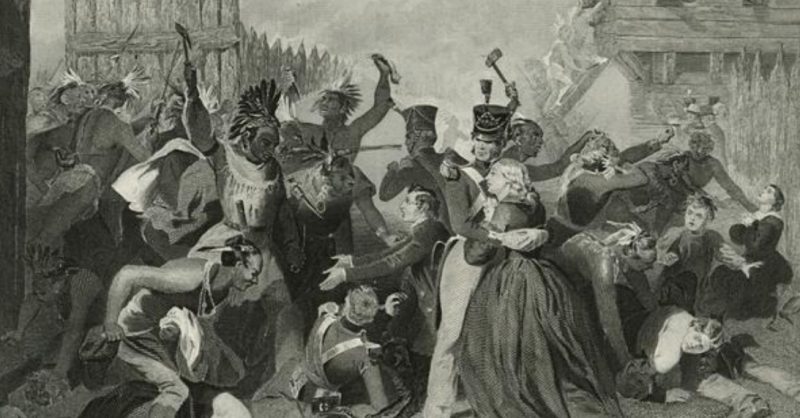Many war leaders are defined by a single incident, one that exhibits their skills, character, and even limitations. For Red Eagle, the Creek Indian war chief and leader in the Creek War, this moment came with the attack on Fort Mims on the 30th of August, 1813.
Lying in Wait
Red Eagle was a cunning and patient warrior. With a force reputedly as large as a thousand warriors, he crept up on the isolated Fort Mims, surrounding it without the inhabitants noticing. Deftly and silently, his troops slid through the surrounding woods, tightening the noose on the men and woman inside.
All of this might have come to nothing if not for the fort’s commander, Major Beasley. Beasley remained unfazed by warnings of an imminent native attack. He sent troops out to investigate one of these reports, but no threat was found, and so Beasley punished the men who had brought what he considered a false warning.
Inside the fort, Beasley’s men relaxed, singing and playing games. Outside the walls, Red Eagle held back his eager men. They had no artillery with which to break open the defences. If they were to get inside, then they would need to seize the gate while it was open, and that would require perfect timing.

The Perfect Time to Attack
Their moment came at noon. The drum for dinner sounded, drawing men away from the gate. Those who remained were lethargic, focused more on their stomachs than on the task at hand.
Keeping his men quiet, Red Eagle led them in a charge on the gate. The men on duty there did not see them until they were thirty feet away. They called out the alarm and rushed to close the gate, but it was too late. The natives overwhelmed them and poured through the gateway, into the grounds of Fort Mims.
Holding the Second Line
Fortunately for Beasley and his men, work had begun on a second line within the outer defences. Though incomplete, this gave them a point to fall back to.
Beasley might not have been a wise commander, but he was a brave one. Rushing to the American line, he joined in the defence of his fort. Among the first defenders to face Red Eagle’s men, he was badly wounded in the fighting, but refused offers of support, or to withdraw to a safe place. He died there on the line, fending off the attack he had been sure was not coming.
The fighting was brutal. Neither side expected mercy from the other. The attackers had superior numbers, but their opponents had defensive positions. Everybody in the fort, soldier or civilian, grabbed a weapon and rushed to the fight. A melee with knives, tomahawks, and the improvised clubs of rifle butts ensued.
Among the attackers were several Creek Indian prophets, men who had helped to stir up war and who claimed to be invincible in battle. This part of their prophecies proved false, as they were cut down by gunfire. While this shook the faith of some of the natives, Red Eagle was not a true believer. He held his courage and kept up the assault.

Dividing the Defenders
Red Eagle was losing many men in his attempt to push past the second line of defences. He needed another way to weaken the defenders.
Dividing his forces, he sent some around the outside of the fort to attack it from different sides. This forced the enemy to divide their numbers to fight off these attacks. Already outnumbered, they were now thinly spread and so more vulnerable to attack. The main assault faced less resistance.
The man who came closest to breaking this strategy was Captain Dixon Bailey. Like Red Eagle, he was a man of mixed blood, but he had chosen the American side in the war. Knowing that native attackers often spent all their energy in the initial assault, he urged his troops to persevere, as things would get better. When it became apparent that Red Eagle’s leadership was keeping the attackers in the fray, Bailey tried to march his men out and fight their way to safety at another fort. But the overwhelming native forces held them in.

Falling Back in Flames
Two of Bailey’s brothers, James and Daniel, turned a house inside the fort into a defensive position, making firing holes in the roof. In response, the natives shot burning arrows into the building, setting it on fire.
Bit by bit, the defenders were forced back across the fort. Building by building, the fire spread, further limiting their options. Women and children did not dare to leave the burning buildings for fear of being massacred. As the last of the defenders were driven back into a single enclosure, most of their officers dead and their home turning into a charred ruin, it became clear that the attackers had won.

Savagery and Sorrow
The brutality of the fighting continued past the point at which all had been decided. Settlers and soldiers alike were massacred by natives, their blood boiling over at the white men’s attempts to take their lands from them. With the heat of battle upon them, few were willing to show calm and mercy.
Red Eagle was among those without a taste for butchery, but he could not control his men. A half-blood of mixed Creek and Scottish ancestry, he had argued for peace in the build-up to the war. Though he had brought them victory, the more hot-headed warriors were not inclined to listen when he called on them to stop.
This was Red Eagle. A cunning and patient tactician. A man of determination but also of mercy. One with enough influence to lead the tribes into war, but not to call them back from it.
The massacre at Fort Mims marked the first great success for Red Eagle in the Creek War, but ultimately it would contribute to his downfall. Enraged at the massacre, the whites flung themselves forcefully into stopping what they saw as a fundamental threat.
